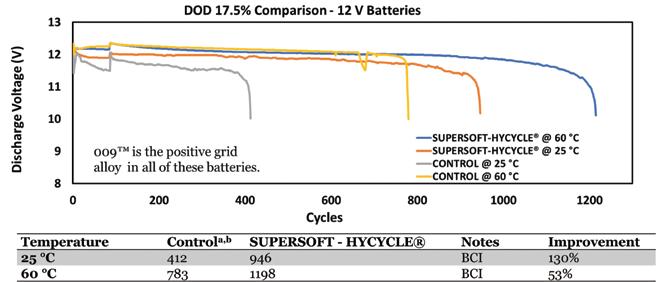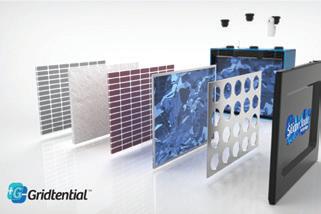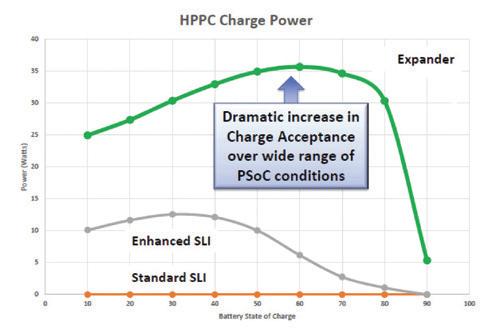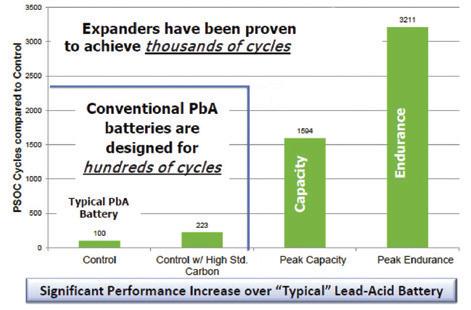
24 minute read
PREVIOUS WINNERS, 2016-2021
Lead silicate as a performance additive
Modern battery applications demand robust performance under adverse external conditions and rigorous duty cycles. One factor affecting performance and service life is stratification of the battery cell electrolyte.
Acid stratification has been a known issue which affects battery life, especially for batteries under heavy cycling or PSoC cycling applications. The increased concentration of sulfuric acid at the lower portions of the battery active material plates promotes the formation of a surface layer of passive lead sulfate and reduces plate activation.
Stratification produces inflated open circuit voltage measurements, reduced battery performance and unequal charge across the plates, each of which can lead to reduced battery life.
Ideally, the electrolyte should be a homogenous mixture of water and sulfuric acid. Due to the exchange reactions of the charge/discharge cycle, a flow of sulfate (SO4-) and hydrogen (H+) ions occurs between the active material surface reaction layer and the bulk of the electrolyte. During the charge/discharge cycle of the battery, acid is absorbed and released by the active material.
The mobility of the H+ ion can cause an increase or decrease in acid concentration (specific gravity).
Under ideal recharge conditions, evolved gasses will properly mix the electrolyte on a frequent basis. During insufficient recharge or extended periods of inactivity, the denser acid will settle to the bottom of the cell creating a density gradient.
This ultimately leads to reduced battery performance through unequal charge across the plate, increased corrosion, sulfation, and active material loss at the bottom of the plates.
Currently accepted methods to combat acid stratification include the addition of “equalization” charges where the battery is charged at a voltage above the gassing limit (2.43V) to induce the electrolytic formation of hydrogen/oxygen gas bubbles. Similarly, air can be mechanically bubbled through the cell to mix the electrolyte.
Alternate VRLA battery architectures such as AGM or gel batteries seek to prevent stratification through immobilization of the electrolyte.
In both architectures, the normally free electrolyte is trapped in either a porous glass fiber matte or transformed into a silica-sol gel by the addition of silica to the sulfuric acid. The silica reacts with the hydrogen ions of the acid to produce a gel network of O-Si-O bonds.
Compared to flooded batteries, VRLA architectures have some disadvantages including increased vulnerability to thermal runaway during abusive charging and the inability to diagnose life-reducing improper charging via electrolyte hydrometer testing.
Overcharging a VRLA battery leads to premature failure and a much shorter service life compared to a properly maintained wet-cell battery. Additionally, AGM and gel batteries are typically twice the cost of flooded batteries.
Hammond’s additives
In search of an innovative solution to the problems of acid stratification, the Hammond R&D team has recently patented the use of novel lead silicate additive compounds in the positive and/or negative electrodes to improve the retention and distribution of H+ ions within the active material.
These additives provide numerous benefits through the following mechanisms: • A network of silica gel (structure) is created inside PAM or NAM, • Mass transfer of acid from the active material to the electrolyte is reduced during charging
The additive material consists of a Pb-Si glass frit. The frit is formed by melting silicon rich quartz glass (sand) and incorporating lead oxide molecules
PUTTING IT ALL TOGETHER
Through experimentation with novel lead compounds, Hammond Group Inc has developed a new lead acid battery additive for both the positive and negative electrode active materials. This lead silicate additive has been shown to react with acidic compounds such as the sulfuric acid battery electrolyte to form both gel-like domains of Si-OH (silane) as well as lead sulfate.
Cells constructed with the additive demonstrate electrical performance similar to the controls, except for an increase in the overall cell voltage during formation and cycling, a decrease in capacity at increased additive loading, and a slight increase in CCA seconds to 1V per cell.
Most importantly, results from full-scale battery testing show that an increase in the additive loading level impacts the degree of acid stratification observed during duty life. It is hoped that further optimization of the additive will achieve greater benefit in the ability to control or reduce acid stratification.
in the form of low metallic yellow litharge (PbO) into the structural lattice.
Pure silica has a tetrahedral structure, and in its crystalline form, silica molecules directly bond to each other via oxygen atoms located at the corners of each tetrahedral pyramid.
Introducing PbO to molten silica causes the partial breakage of the original direct silica interconnections. The resulting lead silicate combines the properties of the two materials and allows the battery’s active material to exhibit the acid-absorbing properties of Si.
Key material characteristics include a high composition of PbO relative to SiO2, similar material density to lead oxide, and low levels of harmful impurities. These properties make the material suitable for use as an additive to lead acid batteries.
Additionally, and most importantly, is that in acidic aqueous solutions such as battery electrolyte, the previously mentioned “chain disruption” of the tetrahedral silica molecules by Pb ions deteriorates the chemical durability of the material.
This allows the H+ ions to replace the modifier cations (Pb+) in the glass network, forming Si-OH (silanol) groups which behave like fumed silica. The additive therefore binds with acid protons in the active material creating pockets of silica-acid gel and combating stratification. The by-products of this reaction are harmless, common chemical species typically found in the battery’s active material such as lead sulfate.
During development of this additive, Hammond’s research team characterized the interaction between lead silicate and the acidic electrolyte solution. Examination of the material’s ability to react with and retain sulfuric acid were carried out in the laboratory. Lead silicate was tested for solubility in both deionized water and 1.4 sg sulfuric acid.
Test results showed lead silicate is negligibly soluble in H2O, however a considerable amount of weight gain (~22%) was observed after reaction with acid. This weight gain was theorized to be caused by the retention of acid in a silica-gel structure and by the formation of lead sulfate.
Examination of the additive before and after acid treatment by SEM-EDS using a Phenom Pro benchtop instrument identified a change in the overall morphology of the starting material as shown in Figure 2.
In the image, one can see the formation of fine granular lead sulfate crystals and smooth greyish regions of exposed silica that occurs after the material reacts with sulfuric acid. EDS probing of these new morphological formations confirms the presence and absence of silicon in each formation.
Electrical examinations
Table 1 presents a summary of the stratification evaluation results conducted on these batteries. Note that stratification was considered to have occurred in the batteries if the difference in specific gravity between top and bottom of the cell was greater than 0.015 (15 points).
The control battery shows acid stratification after the C20 and C100 discharges. The recharging profile of 115% charge returned + 15Ah boost charge is not sufficient to mix the acid well enough in these two cases. As can be seen, the impact on the acid stratification reduction is as follows: Additive in both PAM and NAM > NAM only > PAM only > Control. Based on the discharge data, lower capacity was observed if lead silicate was added to the PAM only, which agrees with prior cell testing data discussed above.
The height of the plate in the Group 27 batteries is 5” (12.7cm). Tall industrial sized battery types will typically see more serious acid stratification and potentially greater benefits from use of the lead silicate additive to reduce this issue.
AWARD WINNER 2021
Table 1. Results of acid stratification measurements during cycle life of Group 27 batteries
Group 27 Flooded Battery (w/ plate height: 5”) Control PAM NAM Both PAM and NAM w/ 1% PbSiO3 w/ 1% PbSiO3 w/ 1% PbSiO3
Battery #
Acid stratification after C5* discharge and recharge** (∆ S.G. between top and bottom)***
Acid stratification after C10* discharge and recharge** (∆ S.G. between top and bottom)***
Acid stratification after C20* discharge and recharge** (∆ S.G. between top and bottom)***
Acid stratification after C100* discharge and recharge** (∆ S.G. between top and bottom)*** D3 A10 B2 C6
0.012
0.014
0.022
0.035 0.005
0.010
0.013
0.024 0.006
0.007
0.008
0.017 0.001
0.004
0.002
0.007
* Before discharge, more charging steps were applied to ensure no acid stratification. Specific gravities (top & bottom) were measured before discharge. ** Recharge profile: 115% of discharge energy + 15 Ah (boost charge step) *** Specific gravity (SG) was measured by digital hydrometer in two cells. The results reported are the averaged value.
Doubling the cycle life of lead batteries
RSR Technologies convincingly won the 2019 innovation award after developing a ground-breaking lead alloy that potentially doubles the cycle life of lead batteries.
The new product, branded and patented — unfortunately all in capital letters — SUPERSOFT-HYCYCLE, contains an engineered suite of microalloying additions, which enhance the cycling and charge acceptance of the active material in a lead acid battery. Known as 009, it is a grid alloy engineered for higher use temperatures, developed by RSR Technologies, a subsidiary of the engineering unit of Eco-Bat Group, following a long history of development.
SUPERSOFT-HYCYCLE was initially launched in the South African market, where it went into commercial production at the South African lead battery firm Auto-X, the maker of the Willard brand of batteries.
Tests showed it doubled the cycle life of lead batteries and greatly reduced water loss,
Tim Ellis, president of R&D at RSR Technologies until moving into semiretirement this June, said the improvement in performance that this product delivers has the potential to help lead acid batteries level the playing field with its main competitor, lithium-ion batteries.
“The fact is that lead acid batteries now have a real competitor in the form of lithium and this can help it compete on performance,” Ellis said. “For such a dominant and widely used technology, lead acid batteries were pretty poorly understood. What we have done is apply science to better understand how they work and, as a result, move their performance closer to what it should be.
“Lead batteries have many other advantanges over lithium, especially the success with which they are recycled, and the availability of the raw material compared with lithium.
“Lithium has always had great cycling and great energy but higher cost and nowhere near the recyclability of lead,” said Ellis. “Lead is less expensive and more recyclable but didn’t have the energy or the cycling. Now it can maintain its low cost and improve its cycling and energy as well.
“If we can improve the performance of lead, without having to reinvent the product, this represents a boost to the entire industry. We are very excited about the potential of what we have achieved here.”
The foundations of the work that resulted in the development of SUPERSOFT-HYCYCLE began with David Prengaman, the president of RSR Technologies until eight years ago, when he retired and Ellis took the reins.
In his earlier years with RSR, Prengaman completed extensive work to remove and analyze impurities in lead. This gradually moved to focus on the effect of adding selected alloys or ‘dopants’ to lead, and assessing the effect on the performance of the batteries in which they are used. Over the years, Ellis estimates that the company tested more than 100 combinations of different alloys in this way.
The tests would focus on the capacity of batteries, their dynamic charge acceptance and their cycle life.
“We tested these things extensively to see what would improve the performance of batteries and we realized that certain combinations would make a big difference to the electrical performance,” Ellis said.
The level of the dopants being added
Above: DOD 17.5% testing of Willard Batteries with and without SUPERSOFT-HYCYCLE show the improvement offered by crystal modifying leady oxide. Below: Performance summary of SUPERSOFT-HYCYCLE performance in 2V test cells.
Product
Control
SUPERSOFT-HYCYCLE Patent 20170317351
Test method
Improvement
One hour capacity (mA-Hrs/mg)
74
84
BCI
13.5% MHT cycle life (cycles)
8,000
42,000
EN 50342:2015
x5 Dynamic charge acceptance (A/A*hr)
0.21
0.49
EN 50342:2015
x2 DoD 17.5% cycles
3,000
4170
BCI
39.0% DoD 50% cycles
810
1140
BCI
40.7% DoD 100% cycles
765
990
BCI
40.1%
is tiny. But he said that in some instances cycle life was improved by some 40%, dynamic charge acceptance by a factor of two and capacity by 10%.
The big breakthrough, however, came when the company secured access to an Advanced Photon Source synchrotron, which is housed at the Argonne National Laboratory and is used in a huge range of scientific disciplines. This allowed it to accurately assess the effect of the proportions of the micro-alloying additions on the micro-structure of the active material. Although the technology had previously been applied to lithium, RSR was the first to apply it to lead.
In essence, it allowed them to watch the performance and evolution of the active material micro-structure in the batteries as they cycled in real time by using the APS synchrotron, allowing far more accurate analysis of the dynamics of crystallization phenomena occurring in the battery during charge/discharge cycling.
“How and why crystals do, or do not, dissolve is key to improving performance in applications,” Ellis said. “Prior to using this, we knew there was an improvement in performance, but we did not know why. This allowed us to see exactly what was going on and the effect it was having on the battery.
“We were able to do this x-ray analysis of the battery plate as it went through the charge and discharge cycle, so we could understand exactly what was going on in the lead. That allowed us to understand how to better engineer the metals to make them more efficient.”
Ellis said the ANL welcomed the idea of looking at lead. In the laboratory experiments that followed, when the SUPERSOFT-HYCYCLE alloy was placed against a control lead element typical of standard lead batteries, the careful selection of microalloying additions and removal of specific contaminants were found to directly aid in changing the PbSO4 to a more easily dissoluble crystal form — thus prolonging battery life.
The cyclability test was based on a specification of a 17.5% depth-of-discharge; normally the cycle rate would be between 800 and 900, Ellis said. Using the RSR alloy it did up to 1,600 cycles.
“This is real; it is not a promise or something that may or may not work. It is real now,” Ellis said. Four years ago Gridtential Energy won the innovation award for its silicon joule technology. This combines the traditional benefits of lead acid batteries, such as low cost, recyclability and safety, with a novel bipolar battery architecture.
This stacked-cell architecture dramatically reduces the weight of the battery and provides it with the power density associated with lithium technology.
John Barton, chief executive of Gridtential Energy, said that by integrating high-volume and lowcost solar manufacturing into the existing lead battery infrastructure, the company has devised an approach that is scalable and should be commercialized, whereas other technologies require novel processing techniques and custom manufacturing equipment.
The commercialization process has proved trickier to execute than previously thought, and it wasn’t until the end of April that Gridtential was ready to launch a series of AGM reference batteries produced on East Penn Manufacturing’s prototype line.
“These are not just samplers but also batteries that are ready to be sold to the market,” said Barton.
The first commercial product is a single-block 24V lead battery optimized for deep-cycle applications. A 12V power version will follow late spring, with 48V versions of each appearing in the second half of the year.
“Silicon Joule technology can also improve the performance of existing SLI and auxiliary batteries by delivering more cranking power over a wider operating range,” Barton said. “The improved power performance is also extremely important in backup applications, such as telecom and UPS, where the batteries are called upon to deliver large currents in sub-second time frames.
“Overall, as demand in high-power applications increases across industries, the Silicon Joule technology’s flexible voltage scalability, thermal management system, recyclability, manufacturability and simplistic design deliver the high dynamic charge acceptance required to meet these evolving performance needs.”
Founded in 2011, Gridtential’s material discovery — the use of treated silicon wafers inside the battery — led to the development of Silicon Joule technology. Gridtential has subsequently attracted the world’s largest battery suppliers, and is eyeing new storage markets across the globe as demand for 48V batteries increases for electric-hybrid vehicles.
Barton said this innovation is important for the lead battery industry, which faces a unique set of challenges brought on by competition from lithium-ion and the reputation of lead commodities.
“Silicon Joule battery technology leverages existing lead recycling infrastructures. But also the amount of lead used in the battery is reduced by up to 40%, significantly decreasing the overall weight of the battery.
“Compared to traditional
Winner —2018 — Gridtential Energy
AWARD WINNER 2019
New bipolar lead battery architecture


How the bipolar batteries stack up
Continued on page 78
COVER STORY: INNOVATION: TRAILBLAZERS FOR TOMORROWAWARD WINNER 2017Gridtential: Continued from page 77 Winner — 2017 — NorthStar
monoblocs, the Silicon Joule battery is lighter and has higher power densities. Gridtential’s approach to battery architecture is built upon a capital-light licensing model that partners with, rather than competes with, battery manufacturers. This allows them to compete against new and emerging technology threats without gigascale capital investments.
“Lithium alone cannot satisfy the global demand for storage,” he said. “As the global EV market heats up and major car manufacturers scramble to secure supply, lithium sourcing challenges loom on the horizon. The same applies to cobalt, which is often used in lithium-ion batteries.”
Additionally, as the multi-billion dollar market for 48V battery systems swells to keep pace with newly increased voltage standards in hybrid-electric vehicles, Gridtential’s Silicon Joule technology will provide its global battery manufacturing partners with an economic, scalable and reliable platform.
Gridtential’s immediate focus is on 12V-48V mild hybrid automotive systems. However, it aims to offer power to a diverse range of technologies across an array of sectors, including material handling equipment, grid storage systems, mobile telephony, back-up power devices for cloud computing, and more.
The first commercial product produced in 2021 is a single-block 24V lead battery optimized for deepcycle applications. A 12V power version will follow late spring, with 48V versions of each appearing in the second half of the year.
Barton encourages lead acid battery manufacturers to embrace this opportunity — and go big.
“While Tesla was aiming for five gigafactories by 2020, existing lead acid battery manufacturers could license Gridtential’s Silicon Joule technology and convert their existing lines to compete with the evolving needs of the battery industry.
“That way, there could be roughly 70 lead acid gigafactories worldwide, with over 500GwH,” he said.
Checking battery health from the cloud’s vantage
Aground-breaking development in remote monitoring came from NorthStar — now part of EnerSys — on the basis of what its then CEO Hans Lidén called its most ground-breaking innovation: NorthStar ACE (Advanced Connected Energy).
This is an IoT service where it connects batteries to a cloud portal.
This means that the battery users can review the battery health and status at any time from anywhere. Furthermore, the embedded battery sensor communicates with both the site technician and the power system, to ensure correct installation and settings. The device has been primarily launched for the telecom sector, but can be expanded to new segments.
“It started in 2015 with a technology assessment to find a good solution for embedded sensors, and when this succeeded, we started developing the sensor communication system, including the cloud portal and mobile app,” Lidén said.
“The work was initiated as part of a broader development strategy, where we analyzed and identified the future growth regions for telecom back-up power and concluded that the growth in remote regions, with challenging conditions, was significant.
“This was a clear driver for developing a remote monitoring solution. In addition, our strategy is to continuously improve both performance and sustainability of our products and we wanted to provide a solution which makes battery usage more efficient and prolongs battery life.”
In addition, a sales and marketing team have in parallel been developing the business proposal for NorthStar ACE.
In terms of how this innovation could potentially change or benefit the battery industry, Lidén said that the biggest di-

NorthStar’s ACE (Advanced Connected Energy), uses an IoT service where it connects batteries to a cloud portal — and from there to any internet connected device, here a smart phone.
rect impact will be longer battery life, but also reduced operational costs for site owner.
“The battery life will be prolonged as installation and settings are done correctly from the start, and the continuous monitoring enables corrective actions when needed and only when needed,” he said.
“Added benefits are better warehouse control, less scrapping and the like, which of course lowers operational costs. An unmeasurable indirect consequence of better control of the reserve power is less site down time, which in turn means that lost revenue due to outages is reduced.”
In terms of the wider world, remote monitoring of reserve power will have an impact on a number of areas. It can, for example, be used in professional transport, where truck drivers more and more depend on power in their cabins when the engine is off.
Data centres are another critical area that depend on reliable reserve power.
“With a better controlled back-up power source, these applications will improve the situation for the users. Enabling remote monitoring also enables better use of renewable power instead of fossil fuels, as the variation of the main power source is compensated with better control of the backup power,” he said.
Looking at a broader scope, increased AWARD WINNER 2017battery life and improved battery utilization means that fewer batteries are needed, which improves sustainability even if the batteries already today have a high recycling rate, Lidén said.
“Furthermore, remote control eliminates a high portion of unnecessary transport to site, which again benefits the environment.
“NorthStar ACE is an advanced solution in a simple package. The batteries look exactly the same on the outside as our traditional batteries, but with advanced features. As the world is talking about the Internet of Things, this may be the first example of connected energy.”
Winner —2016 — Hammond Group
A two-pronged success: LAB2, next gen expanders
Hammond Group, best known in the battery business for its range of expanders, hit the ground running in 2016. It advanced the cause of better lead batteries in two ways — a revolutionary expander formulation and the provision of an open-collaboration research laboratory, known as E=LAB².
Its latest, customizable expanders provide lead acid batteries with dramatically improved dynamic charge acceptance while the LAB2 is dedicated to industry technical development. Its goal is to enable lead acid batteries to achieve 80% of lithium-ion’s technical performance, but at just 20% of its cost.
Dynamic charge acceptance — the way batteries can accept and rapidly store large influxes of energy — is the next big thing for the lead acid business. It opens up two worlds — that of microhybrids in the automotive sector and the huge new areas of business with grid-scale storage.
In laboratory testing and now in production batteries, Hammond has achieved an order-of-magnitude increase in dynamic charge acceptance while simultaneously increasing cycle life.
Figure 1 shows relative comparisons to Hammond’s control samples.
The innovation does not require a change in other battery paste ingredients, grids, or plates. No change in any other material component or process. No new tooling, production technique, distribution, use, scrap characterization, or recycling. This represents a new expander family, with no safety concerns or known adverse effects.
Moreover, this is customizable according to the needs of the batteries being made and their in-service operating conditions.
Hammond has a long tradition in producing lead chemicals for a variety of glass, ceramics, colour and plastic applications.
“We’ve always pioneered technical substitutes and advancements in answer to an ever changing market,” CEO Terry Murphy told Batteries International. “We’ve been very successful adapting to industry’s shifting demand for lead-based chemicals.”
The nub of the problem between lead and lithium is mostly a question of price and recyclability. For advanced energy storage — power generation or hybrid vehicles — lithium-ion batteries meet most of the technical requirements, but are too expensive and not recycled. By contrast lead acid batteries are inexpensive and 100% recyclable, but don’t have the necessary cycle life.
“On a personal note,” said Murphy, “a major influence on Hammond’s decision to invest in our LAB² came from Sally [Miksiewicz], who understood these emerging lead acid battery markets better than anyone, which is why East Penn invested in the Ultra Battery.
“My first meeting with Sally was scheduled for a quick 30-minute introduction, but ended up lasting several hours, with another followup shortly thereafter. We were immediately on the same page — both recognized the need and importance of research to lead the industry forward.”
Hammond has amassed an impressive assembly of state-of-the-art equipment in LAB² — these range from multi-position testing equipment from Maccor and Bitrode, which can test up from mini-cells to SLI batteries to micro-hybrid and stationary testing. There are also general laboratory instruments such as units providing X-ray diffraction,
Continued on page 80
BET Surface Area, UV/Vis spectroscopy.
Gordon Beckley, chief technology officer, said: “With the equipment we have on offer, the huge number of algorithms that can be input to detail the types of usage batteries undergo — and why — that can form the starting point for what performance can be.
“One huge advantage that we can bring to bear is a rapid material and electrode screening process — typically we can make valid performance predictions within a couple of weeks.
“This is unheard of in an industry where typically it takes several months for a clear picture to emerge from research.”
Hammond’s investment in technology is effectively an attempt at a company level to compete against the US government-subsidized advanced battery research, which has focused on lithium-ion.
The traditional lead acid battery suffers a critical, but certainly not unsolvable, technical deficiency. When subject to high-amp, irregular re-charging intervals — such as energy re-capture from braking, battery life may be seriously shortened, said Murphy.
This helped form the background for Hammond’s thinking in looking at ways to see how a better hybrid vehicle battery could be made to accommodate rapid and intermittent charging and discharging. Similarly, an energy grid storage battery must handle the inherent gaps between intermittent wind and solar energy generation and its consumption.
“These applications require a battery to perform well in high-rate partial state-of-charge (HRPSoC) operations, accepting a wide range of charging amps at various states of overall charge, and maintain this quality over a normal cycle life,” said Murphy.
“As a speciality chemical business, I felt that Hammond had an enormous potential to address this deficiency, so we made the investment and the strategic commitment to address the PSoC requirement.”
Hammond investigated the lead acid battery principle failure mode in HRPSoC applications through a materials interaction study, testing traditional and advanced expander materials.
“Exploiting insights on material selection, material interaction and duty-specific formulations, Hammond’s work culminated in its family of negative plate expanders, available for a wide range of HRPSoC applications.
“We’ve discovered a whole new class of materials, but it wasn’t just our new material, or a particular carbon, it was the interaction and exact dosing of these new compounds that was central to this technical breakthrough.”
Charge acceptance improvement Simulated energy storage application


PSoC cycling improvement 2016’s winning entry: expander and E=MC2 laboratory












